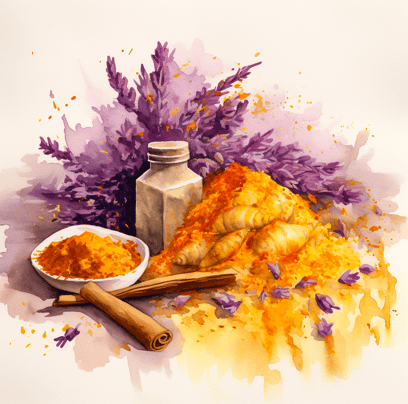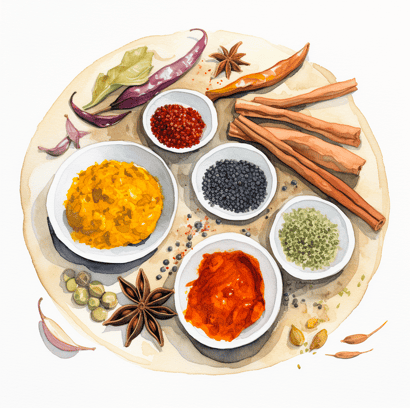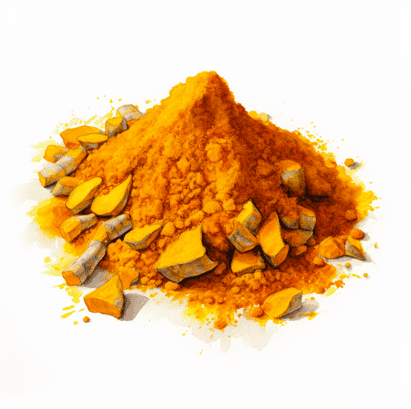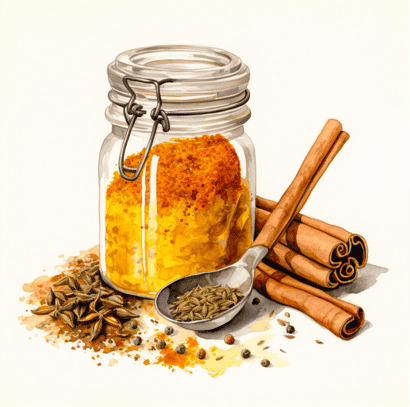
Navigating the spice aisle wondering what’s the benefits of curry vs turmeric can be confusing. Each popular spice looks similar.. but in the end they offer very different flavours and benefits. Which one is better? You’ll find out.
Hi, I’m Hazel
I gave up on skincare after years of issues with acne and sensitive skin.
But after going plant-based, my skin cleared up and even started to glow. Now I help women reveal their natural beauty with simple, delicious plant-based food.
I also used to be a nurse, and love nerding out on nutritional science (high-quality science, that is).

As usual, this post is based on the strongest nutritional evidence I could find with a focus on the simplest, most delicious foods
…because who has time to waste on actions that don’t work?
The quick version:
Curry is a blend of various spices including turmeric, offering a complex flavour profile, while turmeric itself is a single spice known for its bright yellow colour and potent anti-inflammatory properties.
The Basics
Curry

Curry is a versatile spice blend that varies widely but the main ingredients typically includes the ground spices of curry leaves, black pepper, mustard seeds, fenugreek seeds, turmeric, coriander, cumin, and sometimes cardamom, cinnamon, or cloves.
It also contains turmeric, which is where the yellow colour comes from.
Curry is a staple in Indian dishes and for good reason. This mixture of spices offers a rich, complex flavour that can be tailored to different dishes and preferences.
Turmeric

Turmeric on the other hand, is a single spice, known for its bright yellow colour and potent medicinal properties.
It’s made from the root of the turmeric plant and is processed into a fine powder.
As part of the ginger family, turmeric is a fundamental component of many Indian spices mixes but is also powerful enough to be used on its own.
Taste and Aroma
Both turmeric spice and curry powder contain turmeric, yet each has very different flavour profiles.
Turmeric offers a distinctly bitter taste with distinctive flavours that are both earthy and robust. It’s a staple in achieving the bright yellow colour in dishes, often associated with health and vitality.
Conversely, the flavour of curry powder varies significantly because it’s a blend of various spices.
Each curry blend may include different spices, which combine to create a complexity of flavour unlike any single spice. This variety makes curry a fascinating, aromatic addition to any meal, capable of transforming the simplest ingredients into an enticing dish.
Health Benefits

Turmeric and Ginger: Anti-Inflammatory Queens
Turmeric stands out as number one of the most potent anti-inflammatory agents, closely followed by ginger, another root from the same family (1). Their antioxidants also work to reduce oxidative stress.
Integrating turmeric and ginger into your meals can significantly enhance your body’s ability to combat inflammation and maintain cellular health.
Spicing Up Antioxidant Intake
As a food group, spices lead all others in terms of antioxidant content, with turmeric and the variety of spices used in curry blends contributing significantly.
Adding just a tablespoon (about 6 grams) of a curry blend to white rice can reduce the glycemic impact by 19% (2). If you double this amount again, it’s even more effective at reducing glycemic impact 32% (2).
This indicates not just a burst of flavour but a serious boost in meal health benefits.
Beauty Benefits

Natural Skincare Enhancers
The medicinal benefits of turmeric go beyond internal health and extend into beauty treatments.
The bright yellow spices like turmeric are not only visually striking but also potent in protecting the skin. Adding spices like turmeric to your diet can help protect against DNA breakage and reduce signs of ageing (3).
Turmeric spice, while a common ingredient, is actually the most anti-inflammatory food in the world (1).
Defending Against External Stressors
Incorporating spices into your diet can also protect your skin from external damages.
For instance, when spices are added to meat burgers, they can significantly reduce the formation of oxidised fat by-products like MDA by up to half (4).
This action helps in maintaining the integrity of skin cells, shielding against premature ageing and enhancing overall skin health. And in this instance of curry vs turmeric, curry looks to win.
How Much to Use in Recipes
When it comes to using turmeric powder or curry blends in your cooking, moderation is key.
Typically, a teaspoon of turmeric is enough to reap its health benefits and impart its bright yellow colour to a dish without overwhelming the other flavours.
For curry blends, start with a tablespoon for a dish serving four to six people, and adjust according to taste. The variety of spices in curry means its potency can vary, so tasting and tweaking as you cook is essential.
This approach ensures that neither the flavour of curry powder nor the subtle notes of turmeric dominate your dish.
Can You Substitute One for the Other?
Substituting turmeric for curry or vice versa isn’t straightforward due to their distinctive flavours and roles in cooking.
Turmeric’s fine powder form and bitter taste make it ideal for specific uses, such as colouring and imparting a mild flavour to dishes, whereas a curry blend might overpower a dish if used in the same quantity.
It’s important to consider the exact blend of spices in curry when thinking about substitutes, as the flavour of curry powder can vary widely.
Culinary Uses in Indian Cuisine
Both turmeric and curry have their distinct places in Indian cuisine.
Turmeric is often used to enhance the golden spice hue and earthy undertones in rice dishes, soups, and lentils. Its bright yellow spices make it visually appealing and appetising.
Curry blends, featuring a dynamic mixture of spices, are fundamental in creating the rich flavours in Indian curries. From vegetarian korma to chicken tikka masala, these different spices offer a depth of flavour that defines much of Indian cooking.
Experimenting with these main spices can turn an ordinary meal into an extraordinary culinary journey.
Curry vs Turmeric
In wrapping up the curry vs turmeric debate, both spices offer unique benefits to enhance your meals and health. Whether you’re spicing up a dish or seeking health boosts, understanding their distinct flavours and benefits can lead to smarter, tastier choices in your kitchen and life. Embrace the adventure of using both in your cooking to discover just how delicious healthy eating can be!
References
Most references below will link to the original peer-reviewed study itself. However, sometimes I will link to a video over at NutritionFacts.org instead, which is by far the single best resource of brutally transparent nutritional evidence you will ever see. Dr Greger tells a great story about the realities of the science and if I think you will benefit more from one of his videos, the link will take you there instead.
Happy nerding!
- Shivappa N, Steck SE, Hurley TG, Hussey JR, Hébert JR. Designing and developing a literature-derived, population-based dietary inflammatory index. Public Health Nutr. 2014;17(8):1689-1696. doi:10.1017/S1368980013002115
- Haldar S, Chia SC, Lee SH, et al. Polyphenol-rich curry made with mixed spices and vegetables benefits glucose homeostasis in Chinese males (Polyspice Study): a dose-response randomized controlled crossover trial. Eur J Nutr. 2019;58(1):301-313. doi:10.1007/s00394-017-1594-9
- Percival SS, Vanden Heuvel JP, Nieves CJ, Montero C, Migliaccio AJ, Meadors J. Bioavailability of herbs and spices in humans as determined by ex vivo inflammatory suppression and DNA strand breaks. J Am Coll Nutr. 2012;31(4):288-294. doi:10.1080/07315724.2012.10720438
- Li Z, Henning SM, Zhang Y, et al. Antioxidant-rich spice added to hamburger meat during cooking results in reduced meat, plasma, and urine malondialdehyde concentrations. Am J Clin Nutr. 2010;91(5):1180-1184. doi:10.3945/ajcn.2009.28526